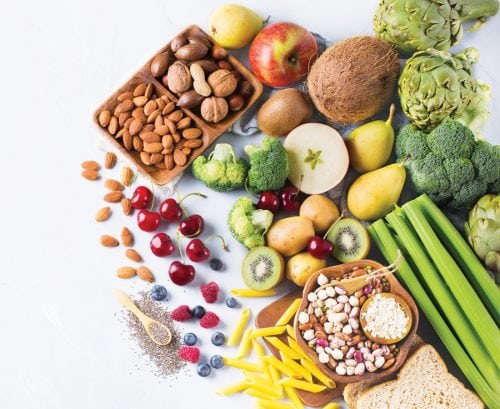
Fibre not only keeps digestion and gut health in peak condition, it helps promote longevity. Niki Bezzant explains.
Back in the day, it was called ‘roughage’. That’s the term for dietary fibre I find in my collection of old nutrition books.
My nana used that word, too. It was a major selling point of her bran muffins.
Now, we know more about fibre. We’ve known for a while it’s important for bowel health, for keeping things moving, so to speak. We also know it plays a role in heart health by lowering cholesterol, along with lowering risk for many other diseases. And we know fibre feeds our gut bacteria, helping keep balanced and healthy the population of trillions of bacteria we carry around.
We recently confirmed even more about the benefits of roughage/fibre. A large study was published in medical journal The Lancet in January, led by researchers at the University of Otago. The study found people who eat higher levels of fibre and whole grains have lower rates of non-communicable diseases compared with people who eat less. The researchers looked at both observational studies and clinical trials conducted over nearly 40 years.
Both types of studies show the same thing – the more fibre, the more benefit. For study co-author, Jim Mann (also a member of the HFG Editorial Advisory Board), this is key. “It’s confirmation that what we’ve said [about fibre] is right.
The data are irrefutable, and the fact we’ve got clinical trial data and cohort data saying the same thing, that’s really – from a scientific point of view – the strength of this paper.”
The results suggest a 15-30 per cent decrease in cardiovascular related and all-cause mortality (that’s death from heart disease, or from anything) when comparing people who eat the highest amount of fibre with those who eat the least. Eating fibre-rich foods also reduced the incidence of coronary heart disease, stroke, type 2 diabetes and colorectal cancer by 16-24 per cent. This translates into 13 fewer deaths and six fewer cases of coronary heart disease per 1000 people.
So, what’s an optimal amount of fibre?
The study says 25g-29g was adequate, but 30g is the magic number, and any increase will provide benefit.
For example, for every 8g increase of dietary fibre eaten per day, total deaths and incidence of heart disease, type 2 diabetes and colorectal cancer decreased by 5-27 per cent. Protection against stroke and breast cancer also increased.
Considering most of us probably only get around the 20g mark, that’s a bit of a gap to cover. So, how can we do it?
To start, we need to know where we get fibre from.
It’s found in plants. There’s no fibre in animal foods. Generally speaking, it’s in things we need to chew. That means vegetables, fruit, whole grains, seeds, nuts and legumes such as beans and lentils. Getting a wide variety of these foods helps us not only get enough fibre, but also a good range of different types of fibre, which is important for those gut bacteria.
For people following low-carb eating plans, getting enough, and a good range, might be a bit of a challenge, since grains and starchy veges are usually off the menu. Professor Mann says you could get 30g of fibre a day just by eating non-starchy veges, but with difficulty. “The amount of vegetables and fruit you’ve got to have is enormous. You’ve really got to include some cereals.”
He recommends wholegrain bread, the grainier the better, plus some cereals and plenty of fruits and veges. “It’s not difficult to get to 30 grams a day, but for someone who likes a lot of meat and a lot of fat, it would be exceptionally difficult, even if you stuff yourself with broccoli.”
We should be cautious of very low-carb diets for that reason, Professor Mann says. “If you wish to have that benefit [of fibre], you can’t do it with a very-low-carb diet.” A range of carbohydrate intake is fine, he says, but we’d struggle to get enough fibre below about 35 per cent of our kilojoules from carbohydrate.
I tracked my own fibre intake and I found it straightforward to get 30g a day when I ate a greater variety of food – oats with chia seeds for breakfast, quinoa in my lunch salad, popcorn as a snack, lots of veges and fruit, etc. On days when I ate less variety – and less carbohydrate – it was a bit trickier.
If you’re eating less bread and cereal, it would definitely pay to balance that out with plenty of seeds, nuts and legumes. And using a tracking app, such as EasyDietDiary, might be useful to get a benchmark, so you can see what you’re getting.
For Professor Mann, the take-home message of this latest research is: the more fibre, the better. “From a nutritional point of view … the protective effect of fibre is probably greater than we first thought, and the magnitude of the benefit is incredibly important.”
Article sources and references
- Reynolds A et al. 2019. Carbohydrate quality and human health: A series of systematic reviews and meta-analyses. The Lancet online ahead of print, doi.org/10.1016/S0140-6736(18)31809-9https://www.thelancet.com/journals/lancet/article/PIIS0140-6736(18)31809-9/fulltext
- University of Otago and Ministry of Health. 2011. A focus on nutrition: Key findings of the 2008/09 New Zealand adult nutrition survey. Wellington: Ministry of Healthhttps://www.otago.ac.nz/
www.healthyfood.com










